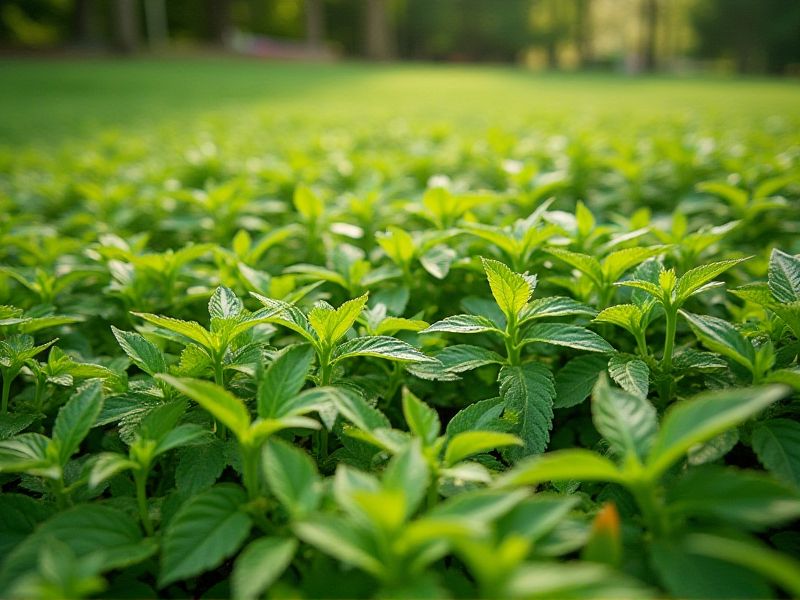
Groundcover plants, such as creeping thyme, are ideal for quickly covering bare soil and preventing weed growth. Boston ivy offers vibrant foliage and can easily climb over walls or fences, creating a lush green backdrop. For a colorful option, consider periwinkle, which produces attractive blue flowers and grows densely. Another excellent choice is sedum, known for its succulent leaves and drought resistance, thriving in various soil conditions. You can create a dynamic landscape by combining different groundcovers for texture and seasonal color variations.
List of some Groundcover plants that spread rapidly
- Creeping Thyme (Thymus serpyllum)
- Blue Star Creeper (Isotoma fluviatilis)
- Bugleweed (Ajuga reptans)
- Creeping Jenny (Lysimachia nummularia)
- Sweet Woodruff (Galium odoratum)
- Periwinkle (Vinca minor)
- Dead Nettle (Lamium maculatum)
- Wintercreeper (Euonymus fortunei)
- Dwarf Mondo Grass (Ophiopogon japonicus)
- Bishop's Weed (Aegopodium podagraria)
Important things about Groundcover plants that spread rapidly
Definition Of Groundcover Plants
Groundcover plants are low-growing vegetation that effectively cover the soil, suppressing weeds while enhancing landscaping with their aesthetic appeal. Rapidly spreading varieties, such as Creeping Thyme and Ajuga, thrive in various conditions, making them ideal for filling gaps in gardens or preventing erosion on slopes. These plants require minimal maintenance and often tolerate drought, ensuring resilience in diverse environments. Incorporating fast-growing groundcovers into your landscape design not only adds beauty but also promotes soil health and biodiversity.
Benefits Of Rapid Spread
Groundcover plants that spread rapidly offer significant advantages for landscaping and garden design. These plants, such as Creeping Thyme or Clover, effectively suppress weeds by covering the soil, thus reducing maintenance efforts. They enhance soil health by preventing erosion and retaining moisture, creating a sustainable environment for other plant life. By choosing fast-spreading groundcover, you can transform bare spots into lush, green landscapes quickly, enhancing the overall aesthetic appeal of your outdoor space.
Ideal Growing Conditions
Groundcover plants thrive in well-drained soil and prefer full to partial sunlight for optimal growth. Regular watering is essential, especially during dry spells, to promote vigorous expansion across your landscape. Consider incorporating native species, such as creeping thyme or clover, which adapt well to local climates and soil types while providing ecological benefits. Maintaining a layer of mulch can help retain moisture and suppress weeds, further enhancing the rapid spread of these resilient groundcovers in your garden.
Soil Requirements
Groundcover plants that spread rapidly typically thrive in well-drained soils with a rich organic content. Depending on the specific species, some may prefer sandy soils, while others flourish in clay or loamy textures. To optimize growth, ensure that the pH levels range between 6.0 and 7.0, as many groundcovers adapt best to slightly acidic to neutral conditions. Incorporating compost or organic mulch not only improves soil fertility but also enhances moisture retention, critical for the vigorous spread of these resilient plants.
Sunlight Preferences
Groundcover plants that spread rapidly thrive in diverse sunlight conditions, ranging from full sun to partial shade. Species like creeping thyme and ajuga are excellent for sunlit areas, offering vibrant colors and dense foliage that can effectively suppress weeds. If your garden has shaded spots, consider using varieties like creeping phlox or hostas, which not only prosper in lower light but also add unique textures and hues. Selecting the right groundcover based on sunlight availability ensures a lush, low-maintenance landscape that enhances your outdoor space.
Watering Needs
Groundcover plants that spread rapidly, such as creeping thyme and ajuga, require careful attention to watering for optimal growth. These low-maintenance plants thrive in well-drained soil and typically prefer consistent moisture, especially during their establishment phase. Overwatering can lead to root rot, while underwatering can stunt their expansion, so aim for moderate watering that allows the top inch of soil to dry out between sessions. By understanding the specific hydration needs of your selected groundcovers, you can create a lush, vibrant landscape that flourishes throughout the seasons.
Maintenance Level
Groundcover plants that spread rapidly are ideal for creating lush landscapes with minimal effort. Varieties like Creeping Thyme and Sweet Woodruff not only thrive in diverse soil conditions but also suppress weeds effectively, reducing the need for constant maintenance. These plants offer additional benefits, such as erosion control and habitat for pollinators, making them a sustainable choice for gardeners. By selecting the right groundcovers, you can transform your outdoor space into a vibrant, low-maintenance haven.
Invasive Potential
Groundcover plants such as creeping thyme, English ivy, and bamboo are known for their ability to spread rapidly, which can pose challenges in garden maintenance and native biodiversity. These aggressive growers often outcompete local flora for nutrients and sunlight, leading to reduced habitat for native wildlife. While they can be beneficial for erosion control and weed suppression, their invasive characteristics require careful management to prevent them from encroaching on other plant species. You should consider selecting non-invasive alternatives or implementing containment strategies if you choose to incorporate these plants into your landscape.
Common Varieties
Consider planting creeping thyme, a groundcover renowned for its rapid spread and tolerance to foot traffic. Another excellent option is ajuga, which thrives in both sun and shade while producing beautiful blue flowers in spring. Lamb's ear offers a soft, silvery foliage that quickly covers bare spots in gardens, as well as a pleasant texture you can enjoy. If you're looking for versatility, sedum varieties such as 'Sedum acre' can carpet rocky areas and withstand drought conditions.
Best Uses In Landscaping
Groundcover plants that spread rapidly are ideal for landscaping as they create lush, green carpets that suppress weeds and reduce soil erosion. Varieties such as Creeping Thyme and Ajuga not only enhance visual appeal with vibrant flowers but also provide habitat for pollinators. Using these low-maintenance plants in your garden can cut down on watering and mowing, making them a practical choice for busy homeowners. Their adaptability to various soil types and sunlight conditions allows you to personalize your outdoor space effortlessly.
